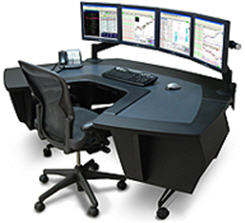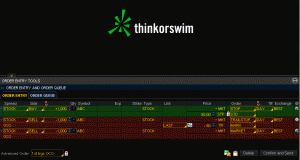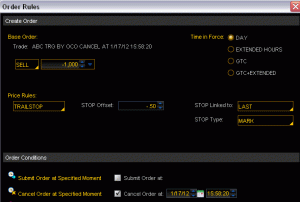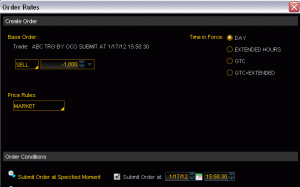Walk Away from Your Day Trades
Intraday plays can offer exceptional opportunities for not only capturing quick moves, but also for managing risk by avoiding the overnight gap risk. It’s a timeframe which full-time traders often participate in, but one which the part-time trader often avoids due to a perceived inability to manage the trade effectively.
 With today’s trading technologies available to us all, there’s no longer an excuse for missing out on moves when away from your screens. The bracket order is a well-known device for the set-it-and-forget-it type of trade, but there are aspects of it which few utilize.
With today’s trading technologies available to us all, there’s no longer an excuse for missing out on moves when away from your screens. The bracket order is a well-known device for the set-it-and-forget-it type of trade, but there are aspects of it which few utilize.
I’ve realized through helping so many part-time traders who desire to capture some intraday moves that it’s common to simply think inside the box. Most of them view a bracket order as an entry, a stop, and a limit order (set at the target). That’s not at all a bad way to do it, and in fact it’s exactly how I use brackets on my swing trades.
Get Creative
For day trades and the bracket order, a little creativity can go a long way. Mix up the parameters from the usual bracket order you use and throw in a couple of different variables.
One of your stop choices is the trailing stop, which can be excellent for intraday trading. This order allows you to designate either a percentage or a price amount which the stock would have to retreat from its best level (since the trade was entered) in order to trigger a closing order. For the trader seeking to grab as much of an intraday trend as possible, this is a great option to have available – particularly in momentum names which have the ability to keep running.
Another choice which can be made is the time stop for managing exits. This order is based on the clock, so once a given time of day is reached, the next action can be triggered (sell!). Since the whole idea of a day trade is to capture intraday movement and not hold overnight, consider setting a time-triggered order to exit the position ahead of the closing bell.
Here’s what the basic order structure would look like on the thinkorswim platform with a stop buy entry if ABC clears $50, with a trailing stop of $0.50 and a time stop for a market sell late in the day (click to enlarge image):
The trailing stop is set to cancel 10 seconds before the time stop, just for the safety of not having the orders overlap (even though there should be no issue). I clicked the little gear icon beside the order on the far right side of the image above, then selected ‘Cancel order at Specified Moment’ and designated an exact time to cancel the trailing stop (click to enlarge):
The time stop is simply a market sell order which will go live at the designated time, in this case 90 seconds before the closing bell. Again, clicking the gear icon brings up this dialogue box where I simply checked ‘Submit Order at Specified Moment’ and set the time (click image to enlarge):
The bottom-line lesson is this: even as a part-time trader, you can still participate in some intraday moves. Use the technology which is at your disposal, and think outside the box a bit. It can help you manage risk effectively, and if the trade works you can lock in some solid profits – without sitting at your desk!
Trade Like a Bandit!
Jeff White
Producer of The Bandit Broadcast
Follow TheStockBandit on Twitter or get our free newsletter to keep up!










Mark | Jan 18, 2012 | Reply
Jeff,
That’s very thought provoking. I think my basic instinct would be to day trade and I had been working on ways around doing that and still keeping the day job. I had picked up the pace of swing trading a bit by trying to tame the volatility of lower priced stocks. I think you are describing do-it-yourself algorithm trading which I find very appealing as it would take away the emotionality of exiting trades. I enjoy the exercise of looking at charts and picking stocks very much, but the exit I find frustrating, usually too early or too late, and I wouldn’t mind automating that part of it and refining the automation as an ongoing process. There would also be the benefit of freeing up the day as you describe. Trouble is, as a beginner, just when I think I have it all sorted out with nice exit rules, back tested and rubber stamped, I find myself heading back to the drawing board, so I have a feeling my algorithm would fail just as much as the person who designed it. Are there any trading platforms that allow you to place stop orders on criteria other than price and time that you know of? For instance a bearish MACD signal line cross stop order as part of a bracket order.
Thanks
I enjoyed the article very much
Mark | Jan 18, 2012 | Reply
Jeff,
That’s very thought provoking. I think my basic instinct would be to day trade and I had been working on ways around doing that and still keeping the day job. I had picked up the pace of swing trading a bit by trying to tame the volatility of lower priced stocks. I think you are describing do-it-yourself algorithm trading which I find very appealing as it would take away the emotionality of exiting trades. I enjoy the exercise of looking at charts and picking stocks very much, but the exit I find frustrating, usually too early or too late, and I wouldn’t mind automating that part of it and refining the automation as an ongoing process. There would also be the benefit of freeing up the day as you describe. Trouble is, as a beginner, just when I think I have it all sorted out with nice exit rules, back tested and rubber stamped, I find myself heading back to the drawing board, so I have a feeling my algorithm would fail just as much as the person who designed it. Are there any trading platforms that allow you to place stop orders on criteria other than price and time that you know of? For instance a bearish MACD signal line cross stop order as part of a bracket order.
Thanks
I enjoyed the article very much
Dr Pennell | Jan 18, 2012 | Reply
Sorry please delete one.
Mark | Jan 18, 2012 | Reply
Got my exit wrong 🙂
Anonymous | Jan 18, 2012 | Reply
Hey Mark,
Yes the broker I mentioned in the post has something called Prodigio which is a fully-functional robot/automated trading system where you can input any variable(s) you want and have it execute trades in that manner. It’s really deep with what you can do with it, so I’d look there first.
Ben9jen | Jan 18, 2012 | Reply
Great info Jeff. Running a business well and trading at the same time can take a guy out of the trading action. I really want to switch brokers, but it will be a hassle! I’m with a discount broker now that is pretty basic in what they will let you do.
Ben
Anonymous | Jan 18, 2012 | Reply
Hey Ben, just keep in mind that the switch is only temporary and may lock you out of trading for a few days. That’s nothing if it brings lasting freedom and flexibility in other ways. Also know that brokers will match prices found elsewhere, because they really want your account and have the ability to negotiate commission rates.